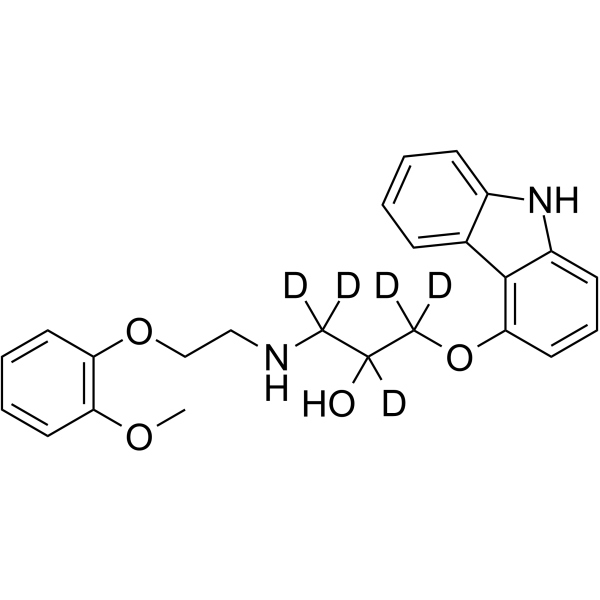Carvedilol-d5
Modify Date: 2025-08-24 22:12:25

Carvedilol-d5 structure
|
Common Name | Carvedilol-d5 | ||
|---|---|---|---|---|
| CAS Number | 929106-58-1 | Molecular Weight | 411.51 | |
| Density | N/A | Boiling Point | N/A | |
| Molecular Formula | C24H21D5N2O4 | Melting Point | N/A | |
| MSDS | N/A | Flash Point | N/A | |
Use of Carvedilol-d5Carvedilol-d5 is deuterium labeled Carvedilol. Carvedilol (BM 14190) is a non-selective β/α-1 blocker[1]. Carvedilol inhibits lipid peroxidation in a dose-dependent manner with an IC50 of 5 μM. Carvedilol is a multiple action antihypertensive agent with potential use in angina and congestive heart failure[2]. Carvedilol is an autophagy inducer that inhibits the NLRP3 inflammasome[3]. |
| Name | 1-(9H-carbazol-4-yloxy)-1,1,2,3,3-pentadeuterio-3-[2-(2-methoxyphenoxy)ethylamino]propan-2-ol |
|---|---|
| Synonym | More Synonyms |
| Description | Carvedilol-d5 is deuterium labeled Carvedilol. Carvedilol (BM 14190) is a non-selective β/α-1 blocker[1]. Carvedilol inhibits lipid peroxidation in a dose-dependent manner with an IC50 of 5 μM. Carvedilol is a multiple action antihypertensive agent with potential use in angina and congestive heart failure[2]. Carvedilol is an autophagy inducer that inhibits the NLRP3 inflammasome[3]. |
|---|---|
| Related Catalog | |
| In Vitro | Stable heavy isotopes of hydrogen, carbon, and other elements have been incorporated into drug molecules, largely as tracers for quantitation during the drug development process. Deuteration has gained attention because of its potential to affect the pharmacokinetic and metabolic profiles of drugs[1]. |
| References |
| Molecular Formula | C24H21D5N2O4 |
|---|---|
| Molecular Weight | 411.51 |
| Exact Mass | 411.22100 |
| PSA | 75.74000 |
| LogP | 4.12890 |
| InChIKey | OGHNVEJMJSYVRP-IZIHCQFESA-N |
| SMILES | COc1ccccc1OCCNCC(O)COc1cccc2[nH]c3ccccc3c12 |
| 2-Propan-1,1,2,3,3-d5-ol,1-(9H-carbazol-4-yloxy)-3-[[2-(2-methoxyphenoxy)ethyl]amino] |
| [2H5]-Carvedilol |